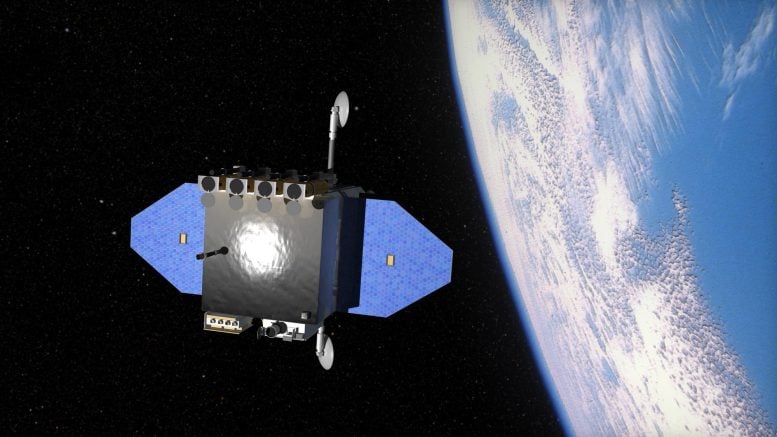
Posted on 11/07/2024 7:06:44 AM PST by Red Badger

NASA’s Solar Dynamics Observatory captured this striking image of a solar flare—a bright flash at the Sun’s center—on November 6, 2024. The image shows extreme ultraviolet light, highlighting the superheated material in the flare, which has been colorized in red. Credit: NASA/SDO
On November 6, 2024, NASA’s Solar Dynamics Observatory recorded a powerful solar flare, peaking at 8:40 a.m. ET. This flare, classified as an X2.3, is intense enough to potentially disrupt radio signals, navigation systems, and power grids on Earth. It also poses significant risks to astronauts and spacecraft operating in orbit.

On November 6, 2024, NASA’s Solar Dynamics Observatory captured a solar flare, visible as an intense flash near the Sun’s center. The image uses extreme ultraviolet light to reveal the flare’s hot material, colorized in red. Credit: NASA/SDO
Solar flares are sudden bursts of energy and light that erupt from the Sun’s surface. They occur when powerful magnetic fields within the Sun become twisted and release their energy, sending out intense radiation across space. This radiation spans a wide spectrum, including visible light, X-rays, and ultraviolet light, and can travel across the solar system at nearly the speed of light. Solar flares are often associated with sunspots, which are cooler, dark regions on the Sun’s surface where magnetic fields are particularly strong.
Solar flares are classified by their intensity, with the most intense types being X-class flares, followed by M-class, C-class, and B-class flares. X-class flares are the strongest and can have significant effects on Earth. When an X-class flare is directed toward Earth, it can interfere with our planet’s upper atmosphere, creating disruptions to radio communications, GPS signals, and even power grids. High-energy solar particles can also pose dangers to astronauts and satellites in orbit, potentially damaging sensitive electronics.
Solar flares are part of the broader phenomenon of space weather, which includes solar wind and coronal mass ejections (CMEs)—huge clouds of charged particles ejected from the Sun that often accompany strong solar flares. Scientists closely monitor solar activity to predict solar flares and mitigate their effects on Earth and in space. NASA’s Solar Dynamics Observatory and other solar telescopes around the world help track these eruptions, providing crucial data for understanding and responding to solar activity that could impact modern technology and space exploration.

Artist’s concept image of the SDO satellite orbiting Earth. Credit: NASA
NASA’s Solar Dynamics Observatory (SDO) is a spacecraft dedicated to studying the Sun’s atmosphere and magnetic activity. Launched in 2010, SDO provides high-resolution images and data, capturing solar activity in unprecedented detail. This mission plays a vital role in NASA’s efforts to understand space weather, specifically focusing on solar phenomena like solar flares, sunspots, and coronal mass ejections (CMEs), which can affect Earth’s communication systems, satellites, and power grids.
Equipped with three main instruments—the Atmospheric Imaging Assembly (AIA), the Helioseismic and Magnetic Imager (HMI), and the Extreme Ultraviolet Variability Experiment (EVE)—SDO measures the Sun’s magnetic field, images the Sun’s atmosphere in various wavelengths, and monitors its energy output. This combination of tools allows SDO to track changes in the Sun’s magnetic fields, temperature, and atmospheric composition, revealing how these factors drive solar activity.
SDO orbits Earth at a vantage point that gives it a continuous view of the Sun, transmitting real-time data 24/7. The information it collects helps scientists make accurate forecasts of space weather events, which are crucial for protecting Earth’s technology and astronauts in space.
WE’RE ALL GONNA DIE!.......AGAIN!......Ping!................
It’s because Trump won the election!!! /sarc
May it hit Denver.
Climate change is normal activity for billions of years, from cycles of activity from SUN. the Sun is million times bigger than puny earth. Humans are puny compared to puny earth. Astronauts in orbit can’t see any man made structures.
Carby-D was right!
If, during the sun’s rotation it does not point at earth there will be no effect.
The Sun is 9 times the diameter of the earth. Your exaggerating.
The sun is 109 times
Allows for 1.3 million earth’s to fit. I learn something new.
IT’S A COSMIC GAME OF RUSSIAN ROULETTE..................
Carby-D!..................................😁

Google diameter of sun
Or any other search site.
1 million earths will fit inside the spherical Sun.
I really just stopped in to see if anyone worked in the usual Uranus joke. ;^)
Seriously though, this topic has a lot of, yes, you guessed it, flair!

“Solar activity remained at high levels thanks to an impulsive X2.3 solar flare around AR 3883 at 13:40 UTC (Nov 6). The event was not responsible for a coronal mass ejection (CME).
A solar filament located in the southwest quadrant erupted beginning around 4:45 UTC (Nov 7). A coronal mass ejection (CME) was flung into space and so far appears to be off the Sun-Earth line. No major impacts expected from this particular event.
In other news, a sunspot group turning into view from off the southeast limb was assigned AR 3889 and is continuing to produce M-Class solar flares. This region along with AR 3883 near center disk will remain the most likely sunspot groups to produce an X-Flare during the next 24-48 hours.”
Even the Sun is hailing Trump’s victory!
Disclaimer: Opinions posted on Free Republic are those of the individual posters and do not necessarily represent the opinion of Free Republic or its management. All materials posted herein are protected by copyright law and the exemption for fair use of copyrighted works.